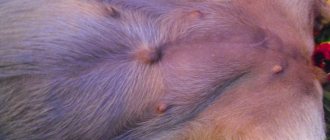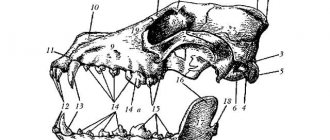It is believed that more than half of dogs are infected with helminths. These are parasitic worms that settle in the body of an animal and feed at its expense. Without treatment, the pathology gradually leads to the death of the parasite's host due to intoxication and damage to internal organs. Therefore, it is important to know why worms appear in dogs, what signs this pathology manifests, and how to help the animal get rid of them.
What to do in such a situation? To get started, we recommend reading this article. This article describes in detail methods of controlling parasites. We also recommend that you consult a specialist. Read the article >>>
Routes of infection
Many are convinced that proper care of their pet protects them from infection with worms. And owners of lap dogs who do not go outside believe that they cannot have parasites. But in reality, any pet can become infected. After all, worm eggs are everywhere. They are on the ground, plants, water and even air. The larvae enter the animal's body through raw meat or fish, or from human shoes.
These parasites are very tenacious and adapt to any conditions. Eggs outside the host’s body can remain on objects and the ground for up to 6 months. Their carriers can be cattle, fish, fleas, and mosquitoes.
The main routes of infection by worms are:
- oral – through the animal’s mouth;
- transmissible - when bitten by blood-sucking insects;
- intrauterine – to puppies from a sick bitch.
A pet can become infected by swimming in a pond, playing in the grass with a stick or ball, or interacting with infected animals.
Tapeworms (cestodes)
Tapeworms are intestinal parasites. Dogs become infected with them by consuming the intermediate hosts of these helminths - fleas, lice, fish, some mammals, etc.
Cestode infections can be asymptomatic for several years and not cause any harm to dogs. However, the animal is dangerous for its owner, as it releases parasite eggs into the environment, and in some cases a person can become infected even without an intermediate host, becoming one himself.
There are four types of tapeworms that most often infect dogs:
- Dipylidium caninum (cucumber tapeworm) – enters the body when infected fleas and lice are ingested;
- Taenia hydatigena – infection through consumption of raw pork meat;
- Echinococcus granulosus – infection through consumption of meat of intermediate hosts (pigs, sheep, etc.).
- Diphyllobothrium latum (wide tapeworm) - infection by ingestion of raw fish or waste from it.
In severe infections with cestodes in dogs, the following may be observed: diarrhea, intestinal inflammation, loss of appetite and weight, intoxication, unpleasant odor from the mouth, constant thirst, dry skin. In addition, a large number of worms in the intestines can cause intestinal obstruction.
Diphyllobothrium latum
Dipylidium caninum
Echinococcus granulosus
Types of helminths
All worms that infect a dog’s body are divided into three groups: nematodes, cestodes and trematodes. Most worms are intestinal parasites. They settle in the digestive tract, feeding on the food that enters there. But they can infect other organs: kidneys, liver, lungs, heart. In many cases, such pathologies without treatment lead to the death of the dog.
Nematodes (roundworms)
These are the most common worms, many of which can be transmitted to humans. They live in the small intestine. But they can settle in the liver or lungs. These are the most tenacious multicellular parasites that are resistant to many treatment methods.
Nematodes are thread-like worms. They are white or light brown. Spread through feces. Blood-sucking parasites can infect your pet.
Nematodes live in the animal’s body for up to 5-7 years, sometimes reaching large sizes. But many species can only be seen under a microscope.
Roundworms cause many serious diseases.
- Ascariasis is the most common type of helminthiasis. It is caused by roundworms - roundworms about 8 cm in size. They live in the esophagus, intestines, liver, gall bladder of a person, from which a dog can become infected. Roundworms will parasitize the animal's body, but will not reproduce.
- Toxocariasis is caused by Toxocara worms. They are larger in size than roundworms. Their larvae are spread by blood and can lodge in the lungs or heart. Eggs enter the body through meat, soil, and are spread on the fur of infected animals.
- The most dangerous nematode infection is dirofilariasis. This disease is caused by large white worms, Dirofilaria immitis. They produce larvae called microfilariae, which are found in the blood. When a mosquito or other blood-sucking insect bites, they get to it. When such an infected insect bites a healthy dog, the larvae enter the dog's bloodstream. Heartworms settle under the skin, in the lungs and heart muscle.
- Hookworm – caused by hookworm. This is a round worm up to 2 cm long, pierces the intestinal walls and sucks blood. They enter the dog's body through the mouth or through the skin through insect bites.
- Uncinariasis develops when uncinaria enters the dog's body. These are small nematodes, about 1 cm long. They live in the small intestine. They enter the body through the skin from blood-sucking insects and through the mouth with dirt.
- A more rare disease is angiostrongylus vasorum. The parasite that causes it is common in the Middle East, Asia, and South America. You can become infected through raw seafood. The larvae penetrate the spinal cord and brain, often leading to death.
- Thelaziosis is also rare. The pathology is common in the Far East and is caused by a nematode up to 1.4 cm in size. Such worms settle in the dog’s eyes and often lead to loss of vision.
Cestodes (tapeworms)
Cestodes are the largest parasitic worms. Their length can reach 10 m. They are also called tapeworms for their specific appearance. Their body resembles a chain with many links or individual fragments. Any fragment can become a source of infection, as it contains many eggs.
Cestodes are tapeworms, they are long and flat. Their mouthparts are equipped with suction cups with sharp hooks that dig into the walls of the internal organs. Infection occurs only through intermediate hosts: fish, meat, blood-sucking insects. Once in the dog's body, cestodes grow quickly. If they accumulate in large quantities, they can lead to intestinal blockage or rupture.
Tape parasites cause several diseases in dogs.
- Diphyllobothriasis is caused by the parasite the broad tapeworm. The length of some individuals reaches 9-10 m. Lives in the intestines, sucks blood, causing anemia. It enters the dog's body through raw fish.
- Dipilidiosis is caused by the cucumber tapeworm. The parasite grows up to one and a half meters. Every day, many eggs are shed in the feces of an infected animal. They enter the dog's body through blood-sucking insects.
- Echinococcosis is caused by a small helminth - Echinococcus. Its length is only 0.5 cm. The parasite settles in the intestines, severely damaging its walls. This quickly leads to the death of the dog. Infection occurs through raw meat and offal. Can be transmitted to humans.
- Coenurosis is a rarer disease that causes brain damage. The larvae are transmitted through contaminated water, soil, and grass. They can be on the animal's fur, in the mouth. The larvae settle in muscle tissue, lungs, and abdominal cavity, and penetrate the brain.
Trematodes (flatworms)
Trematodes are also called flukes. They attach themselves to vital organs. They feed on blood and lymph. These are flat worms that are small in size. Infection usually occurs through raw fish. Trematodes cause less common diseases.
- Alariasis is caused by a small parasite up to 4 mm in size. It is called Alaria fluke. Transmitted through frogs and small crustaceans. Parasites settle in the lungs.
- Opisthorchiasis develops when infected with a cat fluke. The helminth affects the liver and gall bladder of the animal, and can settle in the pancreas. Transmitted through raw water and fish.
- Paragonimiasis is caused by flukes up to one and a half centimeters in size. Transmitted through contaminated water.
What do worms look like in dogs: photos and signs
All helminths that parasitize the dog’s body are divided into three groups: cestodes, nematodes and trematodes. Let's look at each of them in more detail. So, next are worms in dogs: photos with names.
Cestodes
This species belongs to the type of flat (tape) worms. Their flattened body consists of many segments. The length of such worms reaches 10 meters, but there are also small parasites whose size does not exceed 1 cm.
Adults have hooks on their heads for attachment to organs. These representatives of cestodes are most common: bovine and pork tapeworms, echinococcus, broad tapeworm.
Nematodes
This species includes roundworms.
Nematodes most often affect the dog's body.
The body is round in cross-section, reaches a length of 8 meters, non-segmented. Worms are covered with a cuticle (ringed or smooth).
The digestive system is tube-shaped. Prominent representatives of nematodes: roundworms, trichinella.
Trematodes
Such worms are called flukes. Characteristic features include the presence of suckers in helminths (one is located at the front end of the parasite, the other in the middle). The body is shaped like a flat leaf.
Some representatives reach a length of 1.5 meters, but only small flukes, not exceeding a few mm, live in the body of dogs.
How to detect an infestation
Heartworms are very common and any dog can become infected. Therefore, every owner needs to know how to determine that a pet is sick. This will help you start treatment on time and prevent complications.
The difficulty is that many manifestations of helminthiasis are mild and resemble signs of other diseases, for example, poisoning or a cold. But there are several symptoms that require your dog to be seen by a veterinarian as soon as possible:
- changes in appetite, unnatural eating habits;
- hiccups, difficulty swallowing;
- itching of the anus, which manifests itself in the fact that the dog will ride on the floor on its butt;
- nausea, frequent vomiting, alternating constipation and diarrhea;
- the animal becomes lethargic, constantly lies down, does not want to play;
- the fur is tousled, dull, dandruff and bald patches may appear;
- feces with mucus, blood, sometimes you can notice worms or their larvae;
- the stomach is hard and swollen, although the pet looks thin;
- mucous membranes are pale;
- vitamin deficiency and anemia develop;
- allergic reactions;
- The pet's immunity decreases and he often gets sick.
If parasites have settled in a puppy, he will lag behind in development, grow poorly, and refuse food. He clearly has a bloated abdomen and discharge from his eyes and nose.
Symptoms of helminthiases in dogs
Worms can settle in dogs not only in the intestines. In addition to intestinal parasites, there are liver, heart and lung parasites. They cause different symptoms, which you also need to know.
Puppies and small breed dogs are more susceptible to infection.
Intestinal
The most common parasites settle in the intestines. They attach to the intestinal wall and feed on blood or incoming food. This leads to a lack of nutrients in the dog's body. The following symptoms develop:
- constipation or diarrhea;
- vomit;
- stomach ache;
- bloated stomach;
- pallor of mucous membranes;
- weakness;
- lack of appetite.
Hepatic
Some nematodes and flukes settle in the liver and bile ducts. In this case, the following symptoms occur:
- weight loss;
- deterioration of coat condition;
- the liver enlarges;
- itching and dry skin appear.
Pulmonary
If parasites settle in the lungs, they quickly lead to the development of respiratory failure and death of the dog. Therefore, you need to know the symptoms of lungworms:
- nasal discharge, sneezing;
- cough;
- labored breathing;
- anemia and exhaustion;
- hair begins to fall out.
Heartfelt
The most severe case is helminthiasis, in which parasites settle in the blood vessels leading to the heart. This leads to their blockage and death of the animal. It is important to know how to detect the disease on time.
The following signs are noticeable:
- difficulty breathing, shortness of breath;
- dry cough;
- slow pulse, arrhythmia;
- swelling;
- weakness;
- convulsions;
- exhaustion.
In many cases, heartworm treatment is started too late to save the dog.
General information
A dog can become infected with worms everywhere because their eggs and larvae are found in the environment and food.
It is important here not to go to extremes and understand that your goal is:
- Protect your dog from infection with dangerous worms.
- Control the reproduction of common parasites that constantly live in the pet’s body.
A few words about pets that do not roam in public places
It is important for the owner to understand that the dog is still under threat, even if it goes to the litter box and is exclusively held on the street. You go to shops, use transport, banknotes, ATMs, etc.
The entire environment is more or less infested with worm eggs, as they are carried by animals, insects, birds and even the wind. Simply put, you can become a source of infection for your own pet, so the importance of prevention is not discussed.
The pet walks at least twice a day. On each walk, the dog may eat grass, chew sticks, or sniff seeded springs. When a dog sniffs feces, eggs fall on its nose, after which the pet licks itself and swallows the parasites. If there is insufficient training, the dog may pick up leftover food from the ground or examine accumulations of garbage, as you understand, in this case infection is guaranteed.
Most helminths develop and reproduce very quickly. The optimal period for prevention is 3 months. By sticking to a schedule, you can control the reproduction or destroy still young parasites before they cause significant harm. The longer the reproduction of worms does not yield to pressure, the stronger the invasion and intoxication of the host’s body. The dog's body is constantly poisoned by worm waste products.
However, helminths rarely kill their host, unless it is a puppy. Worms struggle to survive when they reach their limit. Dead individuals decompose, which leads to additional intoxication. The longer the invasion continues, the more the animal’s body weakens, but this is not the main harm. The presence of worms suppresses the immune system, which makes the dog vulnerable to any, even mild infections. In addition, some types of worms are able to destroy organs to such an extent that cure is impossible.
There is one very subtle point in treatment with folk remedies - the effectiveness of therapy directly depends on the accuracy of the diagnosis. Simply put, you need to know the type of parasite in order to properly treat it. It is impossible to find out what type of worms your dog has without resorting to laboratory methods. Even stool analysis does not always give the correct result the first time, but parasites can be not only in the intestines, but also in the pet’s organs. For a general understanding, below are the main types of worms:
Cestodes are tapeworms with a flat body, which consists of segments - separate segments. Depending on the subspecies, cestodes grow up to 70–150 cm in length. Each segment contains an egg, it can move and support the life of the larva for some time. When a segment breaks away from the body and emerges into the external environment, it must be eaten by an intermediate host. In the case of dogs, the carriers of cestodes are fleas that eat the larvae.
Toxocaras or roundworms are roundworms up to 5 cm long, usually white or gray in color. The most common type of worms, which is easy to become infected and easy to get rid of. All Toxocara are vulnerable to traditional prophylactic drugs. The danger of this species is that some subspecies, being in the larval stage, can overcome the placental and lactation barrier.
Nematodes are fluke worms that grow up to 2 cm in length, live in the intestines and organs, and feed only on blood. The danger of this species lies in the difficulty of their diagnosis, longevity, reproduction rate and ability to quickly destroy organ tissue.
Not every type of worm can be removed using traditional means. Sometimes parasites are surgically removed to save a dog. In addition, worms can harm internal organs, which requires not only prevention, but also treatment.
Diagnostics
It is often impossible to detect helminthiasis without examination, since the symptoms are vague. It is imperative to conduct an analysis to make a correct diagnosis. Worms are usually found in the feces of dogs, and sometimes blood, urine, and sputum tests are taken.
The doctor will examine the animal and ask the owner about the symptoms. But tests are decisive for making a diagnosis. Sometimes you have to take them again.
Animal treatment
Treatment is prescribed only taking into account the diagnosis. There are broad-spectrum drugs, but they have more side effects and contraindications. It is recommended to give the medicine to the animal in the morning, adding it to food or separately. Modern drugs do not require laxatives or adsorbents to remove dead parasites. But in some cases, when side effects appear, the pet needs to be given activated charcoal or Enterosgel.
Before starting treatment, it is necessary to treat the dog for external parasites, as they are often carriers of worms.
Drugs
Medicines can be given to an animal only after examination. The doctor will choose the most suitable drug. If treatment is long-term or prophylaxis is carried out, medications must be alternated, as parasites develop resistance to them.
For puppies, medications are usually given as a suspension. These are Drontal Junior, Prazicide, Kanikvantel, Triantelm, Pirantel. Adult dogs are prescribed tablets, suspensions or drops on the withers. All medications must be strictly dosed by weight. Broad-spectrum drugs are usually prescribed:
- Azinox;
- Drontal;
- Milbemax;
- Fenbedazole.
Folk remedies
Some owners use antiparasitic herbs to prevent and get rid of worms. But most of them are toxic, cause many side effects and may not help. Such drugs can be used in small quantities for prevention. But it is better to consult a veterinarian first. The following are effective:
- pumpkin seeds or oil;
- chopped garlic;
- wormwood herb powder;
- natural apple cider vinegar.
Therapeutic techniques
What treatment helps with subcutaneous dirofilariasis? Firstly, the worms themselves are removed surgically : the cysts are opened, the parasite is pulled out, the resulting cavity is washed with antiseptic and disinfectant solutions to avoid the development of inflammatory processes. If there are no other options, everything can be covered thickly with any veterinary powder based on streptocide . In general, there will be no special problems with larvae that have already penetrated under the skin. Owners with at least basic veterinary skills can handle this at home.
But it's not that simple. What to do with microfilariae currently in the animal’s blood? And they almost certainly exist, because if your pet is sick with dirofilariasis, then you probably live in an area unfavorable for this disease! Fortunately, there is nothing complicated here either: any anthelmintic drug that acts against parasitic nematodes will do. It is recommended to give the animal two courses of water, with an interval of ten days between taking the medicine. Please note that these drugs may not have an effect on larvae already under the skin. So in the case where microfilariae remain in the animal’s body, they may have to be removed in the future (using the surgical method described above).
But! I would like to remind you that subcutaneous helminths in dogs in this case are the least of the possible problems. Please note that adult heartworms prefer to live in the lumens of blood vessels and the cavities of the heart. So take the time to take your dog to the veterinarian for a full medical examination. It is quite possible that it will save not only the health, but also the life of the pet.
Prevention
To prevent serious illness, prevention is necessary. From the age of two months, a puppy must be dewormed. Adult dogs are given anthelmintic drugs 2-4 times a year. This will help destroy worms at the initial stage if they have entered the pet’s body. It is also necessary to drive away fleas regularly.
It is also important to keep an eye on your dog when outside. It is necessary to prohibit your pet from drinking from puddles, picking up sticks and garbage. It is advisable to keep your pet away from unfamiliar animals. And after a walk, be sure to wash your paws. You should not give your animal raw meat and fish, unwashed vegetables and fruits.
Helminth infections are serious diseases that, without treatment, can lead to dangerous consequences. It is necessary to regularly carry out preventive maintenance and give your pet antihelminthic drugs several times a year.
Development cycle
The adult worm lives in the subcutaneous tissues of the final host and... this is where the difficulties begin. Some hosts have microfilariae in their blood, some do not. What this is connected with is not completely known. Let us remember that these parasites are dioecious. The subcutaneous form of existence is not typical for them in nature. Hypothetically, worms should not and cannot reproduce under such conditions. There are several explanations for this phenomenon:
- Firstly, microfilariae can appear in the dog’s body after “additional” bites from insect carriers. The presence of adult parasites, as you might guess, is not required for this.
- Secondly, pulmonary aortas and heart may already have parasites. Who said that microfilariae must settle under the skin?
- The most exotic theory is that some parasitologists believe that under certain conditions, parasites of the genus Dirofilaria can “mutate” , turning into bisexuals. But this is very, very doubtful; this assumption has never been confirmed in laboratory conditions.
So, the development cycle of worms is closely related to mosquitoes and mosquitoes. In order for first-phase larvae to enter the insect’s body, it must suck blood from an infected host whose blood vessels already contain adult and actively reproducing parasites. The “mosquito” stage of development takes approximately two weeks from the larvae , during which they mature to the third stage. After this period, they are introduced into the salivary glands of the bloodsucker and wait in the wings. When a mosquito bites a dog, microfilariae of the third stage enter his bloodstream and begin to travel through the tissues and organs of the host. It is believed that at this stage of infection there are no clinical signs, but everything is somewhat different...











